| |
|
St Mary,
Banham
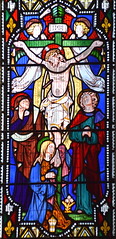 |
|
A large, prosperous south
Norfolk village, fat and sleepy like an old cat
on this day of high heat in August 2018, and the
famous view of its parish church of St Mary is
from the green - the village sign, the war
memorial, and then that magnificent spire lifting
to heaven. It rises more than 40 metres, and is
made of ribbed lead, very similar to the one over
the border at Hadleigh in Suffolk. It had been a
long time since I last visited Banham church,
long enough ago for its size and presence to have
surprised me. The building is pretty much all of
a piece, early 14th century. The Victorians
brought the east window, which Sam Mortlock
thought somewhat excessive in its exuberance, but
the wealth of flowing tracery elsewhere in the
church holds up well against it. You step into a large, well-kept
jewel. Although, inevitably, there was a massive
Victorian restoration here, there is still a
feeling of simplicity, with brick floors and
slightly cluttered furnishings, all overshadowed
by a magnificent west end organ. High above, the
roof bears the date 1622, and the little George
III royal arms look like a postage stamp above
the high tower arch. The star of the show is the
luscious range of 19th and early 20th Century
glass, much of it the work of Powell & Sons.
The 1857 east window, unusually, is a cavalcade
of geometric designs in pressed glass, with at
its centre a crucifixion. The artist was John
Clayton, a vigorous scene, his watchers looking
up in an agony, showing what he was capable of
before Alfred Bell came along and made him
serious. It is reminiscent of the work of Robert
Bayne in the same decade.
|
The other 19th Century Powell &
Sons glass is to the designs of the great Henry Holiday.
The earliest echoes the style of the east window, with
medallions of the Baptism of Christ, the Adoration of the
angels at the Nativity, and the Ascension of Christ. The
best, in the south aisle, depicts gorgeously rich figures
of the four Evangelists, each in their own light over two
windows.
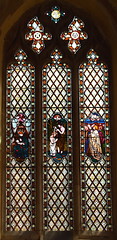  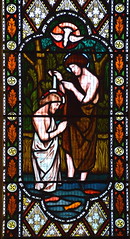 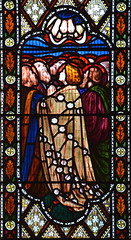
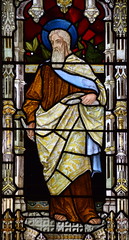 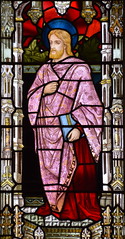 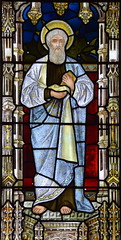 
The richness of these was echoed
half a century later by a Powell & Sons window of
1936, which is probably the freshest and most memorable
thing in the whole church. The risen Christ stands
between two lights, one depicting spring with sheep
grazing beneath an apple tree in blossom, the other
autumn with the tree in fruit above rabbits and birds. It
would be interesting to know who the artist was. The
window beside it of the Presentation in the Temple is by
Kempe & Co, and seems curiously out of place as if
simply not speaking the same language, but then I've
never been a fan of Kempe glass.
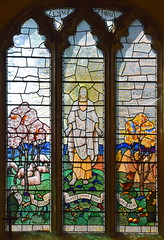 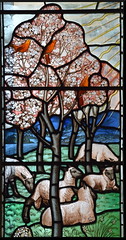  
The earliest English glass is in
the chancel, a range of the twelve disciples and a Tudor
arms all in a pre-Ecclesiological style. It probably
dates from the 1830s, and has not worn well, the painted
details have long since faded and all that remains are
mosaics of coloured glass suggesting human figures.
However, there is a very good 16th Century continental
image of the Blessed Virgin and child in the north aisle,
collected from elsewhere and set here in the 1960s. In
the east window of that aisle is a single 19th Century
panel depicting Christ with Martha and Mary at Bethany,
which seems so odd to find in isolation that I think it
may too have come from elsewhere.
At the east end of this
aisle lies a wooden knight, life-size and rather
severe in his simplicity inside his tomb recess.
He is popularly believed to be Sir Hugh Bardolph,
founder of the church, but as Pevsner drily
notes, given that Bardolph died in 1203 and this
effigy is early 14th Century, it is a bit too
much of an afterthought. Woodwork of a later
time surmounts the font on its stepped pedestal,
a grand gothic font cover of the 1860s that might
take its inspiration from the Albert Memorial.
The screen came next, and by the end of the
century the two richly carved reredoses in the
sanctuary and the north aisle chapel.
On this day of bright sunshine on a day in high
summer, the temperature dipping up into the
thirties, this felt a proud, confident place, a
real statement of 14th Century confidence coupled
with 19th Century piety and energy. But I
remembered being here once before, some fifteen
years ago, late on a December afternoon. The low
sun made the shadows long, and inside the church
the south aisle windows glowed as if they were on
fire as the nave and chancel darkened. And as I
sat there, the day faded. I could hardly see the
settings on my camera any more, but Christ in the
apple orchard still glowed fiercely, the
brightest of the jewels, as if on its own holding
back the sinking sun. And then, as the afternoon
deepened, the windows around darkened, like stars
fading, and this was the last to go out. |
|
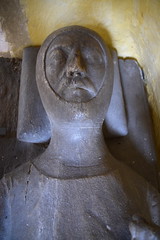 |
|
|
|
